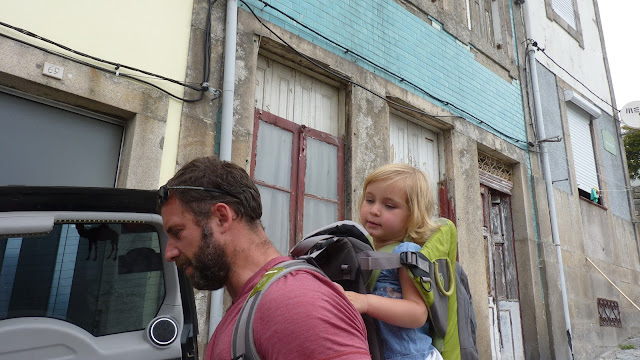Porto
Porto is the second biggest city in Portugal and it is indeed quite big so I was a bit apprehensive about visiting it. I don't really like big cities. They are crowdy, polluted with too much traffic and little room to park the car. Despite fitting the description quite well, Porto stole my heart. I loved it! I loved Ribeira, the old part on the river bank, Vila Nova de Gaia with its wineries and everyhing else in between.
Getting ready to explore Porto
We decided to do sightseeing the easy way this time and hopped on a train that took us to a winery and around some sights in the old town.
Ponte de Dom Luis I - double decker, bottom part for cars, top for metro trains and pedestrians, designed by a student of Gustav Eiffel
The stop at the winery Real Campanhia Velha in Vila Nova de Gaia which is the part of Porto where most if not all wineries are. We learnt a great deal about port wine – Aaron’s favourite. We were the only English speaking passengers on the train so we had a guide to ourselves. The rest of the passengers were Polish so they had their own guide.

In the cellar
The white poster in the photo with Beany is on a barrel, actually in the middle of it. The barrel to the right contains the oldest wine in Portugal.The date on the barrel is the
date of the harvest and at the same time the production of the wine. Due to the
age this wine is treated as national treasure. It is regularly checked by wine
experts from Portuguese institute of port wine and apparently it is still
aging. The current price for this particular barrel of wine is €10000. The
barrel itself isn't as old as the wine as barrels can ‘only’ last a hundred
years after which time they have to be changed.


The best part of the trip: the
wine tasting


One very happy customer
Back on the train

Porto has plenty of buildings
covered inside and out with azulejo –
hand painted tiles presenting various stories. Here’s some examples.
Igreja
de Sto Ildefonso Igreja
dos Congregados



Sao Bento Train station with more azulejo inside.
Just like in Braga there
were many abandoned buildings in Porto.
Views from the cathedral hill.

Se – hilltop fortress overlooking
the river and city, founded in XIIC.
Views of Riberia – Porto’s
riverfront nucleus- from Ponte de Dom Luis I
And looking at the other side of
the river from the very same bridge – Vila Nova de Gaia with its wineries.

Igreja de Sao Francisco
Palacio da Bolsa – The Stock
Exchange Palace
Here the stock exchange
transactions happened until 1994 when the stock exchange market got transferred
to Lisbon. The building was built from 1842 to 1910. It seems like a long time
for a building to be built, however considering that a certain room took 40
years to complete I’m surprised the building was ever completed!
This is the room where the stock
exchange transactions took place.
Here’s the room which completion
took 40 years.
And
here’s one of two chandeliers from that room, each weighs 3.5 tonnes.
Gustav Eiffel lived in Portugal
for a couple of years and in the room below he designed one of less recognised
bridges in Porto.
The most impressive room in the
Stock Exchange Palace: The Arabic Room. There is no link between the Arabic
world, the religion or any Muslims and the Stock Exchange Market in Portugal
nor the Queen who ordered the palace to be built. It was simply a fashion at
the time to have an Arabic room. This one has pure gold on the walls, 20kg of
it apparently! The room is for rent for €7000 a night. The price only includes
the room. If one would like to have dinner there, the price rises to €40000 a
night! And it does get rented!
I was the only one visiting the
Stock Exchange Palace. Others were involved in different activities.
An afternoon walk in Ribeira
Praca da Ribeira
The campsite from which we explored Porto, situated in a nearby town, about half an hour drive from Porto.
15-16 July 2015










































No comments:
Post a Comment